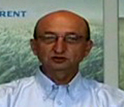|

Media Advisory 08-032
NSF Press Briefing: Green Gasoline

A renewable petroleum alternative from plants; briefing on Sept. 23
September 15, 2008
This briefing will be open via telecon. Dial (888) 324-3618 (toll-free domestic) or 1 (212) 287-1639 (toll international) and announce the pass code Green Gasoline to join the event where you will have an opportunity to listen and ask questions.
View video interviews with John Regalbuto of the National Science Foundation, biochemist Clint Chapple from Purdue University, Randy Cortright, CTO of Virent Energy Systems, and chemical engineer George Huber from the University of Massachusetts at Amherst.
First-generation biofuels have been hampered by a range of factors, from incompatibility and lower energy yields to concerns about their potential impacts on food prices. A new, second-generation biofuel known as cellulosic gasoline, or "green gasoline," is positioned to bridge those gaps and eventually provide gasoline, diesel, jet fuel and other chemicals that are identical to petroleum counterparts yet are derived from non-food plants and agricultural waste. Breakthroughs emerging this year are ushering in a period of rapid development in green gasoline research, and now some of the largest petroleum companies in the world are joining the effort. On Sept. 23, 2008, three leading experts from academia and industry will host a panel discussion at NSF to highlight how far researchers have come, and how far they still need to go, to bring plant-derived gasoline to market. | Who: | John Regalbuto, chemical engineering professor at the University of Illinois at Chicago and the Catalysis and Biocatalysis Program Director at the National Science Foundation
George Huber, chemical engineering professor from the University of Massachusetts, Amherst
Randy Cortright, CTO of Virent Energy Systems | | What: | Discussion of the present and future of green gasoline research | | When: | Tuesday, September 23, 2008, at 2:00 p.m. ET | | Where: | National Science Foundation
Room 110
4201 Wilson Blvd.
Arlington, Va. (Ballston Metro Stop) |
Check in at security desk, 9th & Stuart St. entrance. For Directions, see http://www.nsf.gov/about/visit/. RSVP to Josh Chamot, media officer for engineering, at jchamot@nsf.gov. Note: On September 27, NSF will be at Family Day at the U.S. Botanic Garden, just across First Street SW from the U.S. Capitol, to display typical "green energy" plants used in green gasoline production-along with a sample of "biocrude" and the catalysts used to create green gasoline from plants-and to answer questions from the public. The plants are being provided by the USDA U.S. National Arboretum courtesy of their Power Plants-Farming Energy exhibit.
-NSF-

Media Contacts
Joshua A. Chamot, NSF (703) 292-7730 jchamot@nsf.gov
Related Websites
Additional information: http://www.nsf.gov/news/newsmedia/greengasoline/index.jsp

The National Science Foundation (NSF) is an independent federal agency that
supports fundamental research and education across all fields of science and
engineering, with an annual budget of $6.06 billion. NSF funds reach all 50
states through grants to over 1,900 universities and institutions. Each year,
NSF receives about 45,000 competitive requests for funding, and makes over
11,500 new funding awards. NSF also awards over $400 million in
professional and service contracts yearly.
 Get News Updates by Email Get News Updates by Email
Useful NSF Web Sites:
NSF Home Page: http://www.nsf.gov
NSF News: http://www.nsf.gov/news/
For the News Media: http://www.nsf.gov/news/newsroom.jsp
Science and Engineering Statistics: http://www.nsf.gov/statistics/
Awards Searches: http://www.nsf.gov/awardsearch/
| 





